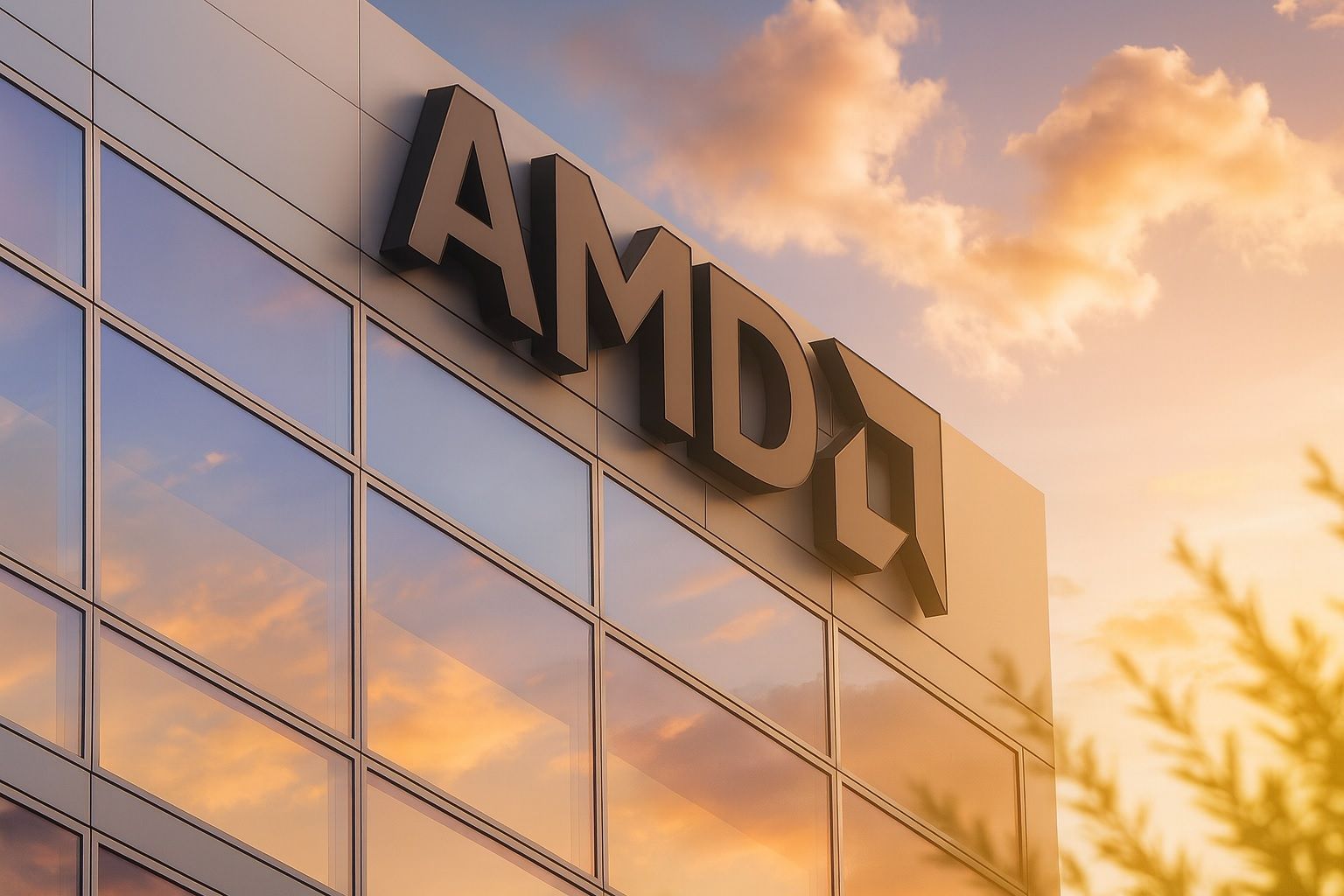- AMD hovers around $253 per share on October 27, 2025, near its all-time high after surging ~6.5% last Friday [1]. The stock is roughly flat in Monday’s early trading [2], holding onto massive year-to-date gains of about 90% [3].
- AI deal frenzy powers the climb: AMD’s shares have nearly doubled in 2025 amid a string of blockbuster AI partnerships. An OpenAI chip supply deal (Oct. 6) sent the stock up 34% in one day [4], and an Oracle Cloud GPU order (Oct. 14) added another bump [5]. Most recently, an IBM quantum computing breakthrough on AMD chips sparked a 7–8% jump on Oct. 24 to new record highs [6].
- Wall Street turns bullish: Major analysts are hiking forecasts after these wins. Bank of America now pegs AMD’s 12-month price target at $300, citing “positive announcements at the 2025 OCP Summit” that bolster confidence in AMD’s next-gen AI hardware [7]. HSBC raised its target to $310, and others like Jefferies and Mizuho now see AMD in the high-$200s [8] [9]. Dozens of analysts have upgraded AMD to a Buy, forecasting further upside – though a few skeptics remain Neutral with targets near $210 [10].
- Big gains, big expectations: AMD’s market cap has swollen to around $350–$380 billion [11], ranking it among the world’s top chipmakers. The Philadelphia Semiconductor Index is up ~32% this year [12], reflecting broader AI-fueled euphoria lifting chip stocks. Yet AMD’s valuation (over 100× trailing earnings) leaves “little room for error” going forward, analysts warn [13]. Any stumble in delivering promised growth – including the $100+ billion in new AI revenues AMD expects from recent deals [14] – could trigger a pullback.
- Showdown in AI chips: AMD’s latest moves position it as NVIDIA’s strongest challenger in data-center AI. NVIDIA still commands ~90%+ of the AI GPU market [15], and even Intel is re-entering the race with new chips due in 2026 [16]. AMD’s strategy is to offer an “open” alternative to NVIDIA’s proprietary ecosystem, combining its Instinct GPUs, EPYC CPUs and new “Helios” supercomputer platform to win over big cloud players [17]. Early adopters like OpenAI, Oracle, and Meta are already on board for AMD’s next-gen chips in 2026 [18], validating AMD’s approach – but the company must execute flawlessly to secure lasting market share gains in the face of fierce competition.
AMD Stock at Record Levels on Oct. 27
Advanced Micro Devices’ stock is starting this week right near its all-time high after a breathtaking rally in recent weeks. As of Monday morning (Oct. 27), AMD traded around $252–$253 per share [19], essentially unchanged after its record-setting jump last week. On Friday Oct. 24, AMD soared roughly 7% intraday and closed in the low-$250s – a new peak that put the stock up about 90% year-to-date [20]. That blistering rally far outpaces other chip giants (for comparison, NVIDIA’s stock is up around 40–50% YTD, and Intel’s only modestly higher) [21].
This latest surge crowned AMD as one of 2025’s top-performing tech stocks. The company’s market capitalization now sits in the upper hundreds of billions (around $370B at current prices), underscoring how dramatically investor sentiment has swung in AMD’s favor amid the AI boom [22]. Broader markets have likewise been buoyant – the Nasdaq and S&P 500 hit all-time highs recently on AI optimism [23] – but AMD’s climb stands out even in an exuberant field. The question now is whether AMD can keep up the momentum and fundamentally justify its lofty valuation as we head into the year’s final stretch.
AI Mega-Deals Drive the Rally
The catalyst behind AMD’s red-hot stock price is a series of blockbuster AI deals and breakthroughs unveiled in October. The rally kicked off with a bang on October 6, when AMD announced a multi-year partnership with OpenAI (the maker of ChatGPT) to supply cutting-edge AI chips. The agreement calls for AMD to deliver roughly 6 gigawatts worth of its Instinct GPUs – amounting to hundreds of thousands of high-end chips – starting in late 2026 [24]. In an unprecedented twist, OpenAI also secured warrants to buy up to ~10% of AMD’s shares at a nominal price as certain milestones are met [25]. Those milestones include ambitious stock-price targets (reportedly up to $600 per share for the final tranche) [26], underscoring the massive upside both parties envision.
AMD’s CEO Lisa Su hailed the OpenAI pact as a “win-win, enabling the world’s most ambitious AI buildout” that will be highly lucrative for AMD over time [27]. Indeed, AMD projects the OpenAI deal (and related business it spurs) could generate “more than $100 billion in new revenue” over the next four years [28] – a staggering figure roughly 4× AMD’s total sales last year. Investors responded with euphoria: AMD’s stock spiked over 34% in a single day on the OpenAI news [29], its biggest one-day gain in nearly a decade, adding about $80 billion to the company’s market value overnight.
Just a week later, AMD notched another high-profile win. On October 14, Oracle announced it will deploy 50,000 of AMD’s forthcoming MI450 GPUs in its cloud data centers, as part of new “AI supercluster” installations [30]. This huge order – slated to roll out in 2026–27 – signaled that Oracle sees AMD’s next-gen chips and “Helios” server platforms as critical to expanding its AI cloud services. Oracle touted the partnership as delivering the “best price-performance, open, secure, and scalable” infrastructure for AI workloads [31]. Even on a day when broader markets wobbled, the Oracle deal gave AMD a 3% pre-market boost [32], reinforcing that any credible AI win can move the stock higher in this climate.
Most recently, a surprise breakthrough provided another jolt. On October 24, IBM researchers revealed they ran a quantum computing error-correction algorithm on AMD’s standard data-center chips – a task previously thought to require specialized quantum hardware. This validation of AMD’s technology in advanced computing contexts electrified traders. AMD shares jumped about 7–8% that day to a new record high, as the news stoked optimism that AMD’s chips have broad capabilities beyond traditional uses [33]. (IBM’s stock leapt as well on the development.) The quantum-computing feat added more fuel to AMD’s October run, capping off a remarkable string of announcements.
All told, in the span of a few weeks AMD has secured deals with the marquee names in AI – OpenAI and Oracle – and even had its hardware underpin a novel IBM achievement. “We view this deal frenzy as certainly transformative, not just for AMD, but for the dynamics of the industry,” AMD executive Forrest Norrod told Reuters of the OpenAI partnership [34]. Industry watchers likewise see it as a major vote of confidence in AMD’s AI roadmap. “AMD has really trailed NVIDIA for quite some time, so I think it helps validate their technology,” said Leah Bennett, chief investment strategist at Concurrent Asset Management [35]. In other words, AMD’s recent wins suggest it can carve out a bigger slice of the exploding AI chip market – even if unseating NVIDIA’s dominance will be an uphill battle.
Analysts Raise Targets – $300 in Sight
Wall Street has wasted no time responding to AMD’s rapid ascent – analysts across the board have been revising their models upward and issuing dramatically higher price targets. In the past two weeks alone, a flurry of bullish calls has put $250–$300+ targets on the stock, implying expectations of further upside from current levels.
For example, Bank of America chip analyst Vivek Arya hiked his 12-month target to $300 (from $250 prior) after seeing AMD’s new AI deals and product roadmap. He cited “positive announcements at the 2025 OCP Global Summit” (like the OpenAI/Oracle news and the unveiling of AMD’s Helios system) that give greater “visibility” into AMD’s growth trajectory over the next 1–2 years [36]. Arya reiterated his Buy rating and noted that the expanded AI partnerships could translate into around $10+ in annual earnings per share by 2027 if all goes well – a level that would indeed justify a $300 or higher stock price [37].
Jefferies and HSBC likewise joined the $300 club. Jefferies boosted its target from $200 to $300, while HSBC made one of the most aggressive calls, upping its goal to $310 (from just $200 previously) in mid-October [38]. Wolfe Research upgraded AMD to “Outperform” and set a $300 target as well, saying the company now appears on a “conservative path to $10+ earnings power” by 2027 thanks to the OpenAI deal’s boost to long-term demand [39].
Even analysts who aren’t yet at $300 are raising their outlook. Mizuho recently lifted its target from $205 to $275 (Outperform) and Wells Fargo similarly went to $275 (Overweight) after AMD’s October announcements [40]. Citigroup bumped its target to $215 (Neutral) from $180. In fact, according to MarketBeat data, AMD now has at least 29 Buy or Strong Buy ratings versus only one Sell, and the average price target has climbed into the mid-$200s [41]. (TipRanks pegs the consensus around ~$250, up from ~$220 a month ago as new upgrades rolled in.) Just a few holdouts remain cautious – for instance, Goldman Sachs and Citi have stuck with more subdued ~$210 targets and “Neutral” stances [42], suggesting they see AMD’s recent run as fully pricing in the good news.
Overall, though, the sell-side mood has clearly shifted to bullish. The OpenAI and Oracle deals are viewed as validation that AMD can compete in the AI arena, prompting analysts to bake much higher future revenue and profit into their models. “AMD’s OpenAI deal paves the way to [a] $300 price target,” one analyst was quoted as saying last week [43]. The chorus of $275–$300+ targets reflects a belief that AMD’s earnings will ramp significantly in coming years as those partnerships materialize. At the same time, the exuberance comes with a note of caution: AMD’s stock has run so far, so fast that any slip could disappoint. “At current levels, AMD’s valuation is very high… leaving little room for error – any slowdown could trigger profit-taking,” one analysis warned [44]. In other words, Wall Street is bullish but will be quick to punish even minor setbacks to the rosy growth narrative now priced in.
High Hopes vs. High Valuation
After its dramatic climb, AMD is no longer a underdog stock by any means – it’s a market darling with a premium price tag. The company’s forward price-to-earnings ratio has ballooned to around 40× its expected 2026 earnings, and over 100× its trailing 12-month earnings [45]. By comparison, rival NVIDIA trades around 28–30× 2026 earnings [46], and the broader S&P 500 is closer to 20×. This means AMD’s valuation now assumes a lot of future growth. As TS2.tech observed, the current multiples leave “little room for error” – essentially, AMD must execute nearly perfectly on its AI strategy to grow into the optimism already baked into the stock price [47].
Bulls argue the high valuation is justified by AMD’s expanded opportunities. If the OpenAI and Oracle deals indeed bring in tens of billions in new revenue, and if AMD’s upcoming MI300/MI400 series chips gain traction, the company’s earnings could multiply over the next 2–3 years. Management is guiding for about $8.7 billion in revenue in the upcoming Q3 report (to be released Nov. 4), which would be ~20% higher year-on-year [48]. AMD’s last quarter saw record sales of $7.68B (+32% YoY) [49], and the company is targeting roughly $33 billion in revenue for full-year 2025 [50]. Clearly, AI-related demand is already boosting the top line. If those trends accelerate with the new partnerships (which start impacting revenue in 2026 and beyond), AMD’s earnings could climb enough to eventually “grow into” its valuation.
However, any hiccup along the way could be painful for shareholders at these levels. Potential risks include product delays (AMD needs to deliver its next-gen chips on time to fulfill deals), supply constraints in chip manufacturing, or a scenario where AI demand shifts and Nvidia or others maintain their chokehold on the market. There’s also the broader market context – macro factors like interest rate changes or trade restrictions on chips (e.g. U.S. export curbs to China [51]) could temper the exuberance around semiconductor stocks. In the near term, traders note that AMD’s chart is extended: after a virtually vertical move this month, some pullback or consolidation wouldn’t be surprising. Key technical support is now around $230–$240 (the zone of the prior highs), and on the upside, a decisive breakout above the mid-$250s could “pave the way toward the $270–$300 region,” according to market technicians [52]. In short, the upside potential is substantial if AMD continues firing on all cylinders – but the expectations bar has been set very high.
The Battle for AI Chip Supremacy
AMD’s surging fortunes come as the semiconductor industry enters a new phase of competition centered on artificial intelligence. For years, NVIDIA has dominated the AI accelerator space – holding an estimated 90–94% share of the data-center GPU market [53] – thanks to its powerful hardware and software ecosystem (CUDA and related AI libraries) that most AI developers rely on. AMD was late to the party in AI chips, and Intel had been largely absent from high-end GPUs. Now, the landscape is shifting. AMD’s recent deals with AI titans show that top customers want a viable alternative to Nvidia’s offerings, both for cost and supply reasons. AMD is pitching itself as that alternative with an “open-platform” approach: leveraging standard interfaces and open software, and integrating its CPUs, GPUs, and networking tech into turnkey AI systems (like the new Helios racks) that big cloud players can customize [54]. This contrasts with NVIDIA’s more vertically integrated, proprietary approach.
The interest is definitely there – besides OpenAI and Oracle, Meta Platforms (Facebook’s parent) is reportedly evaluating AMD’s MI300/MI450-based systems for its own AI data centers [55]. By 2026, AMD could be supplying multiple hyperscale cloud companies with advanced AI chips, something that seemed unlikely just a year ago.
Meanwhile, Intel is keen not to be left behind. At this month’s Open Compute Project summit, Intel unveiled a forthcoming data-center AI chip called “Crescent Island,” aimed at AI inference tasks, due in 2026 [56]. Intel is also adopting a more modular, open stance – even NVIDIA took a 4% stake in Intel (a $5 billion investment) to co-develop some future chip technologies [57]. This shows how strategic the AI silicon race has become: yesterday’s rivals are striking alliances, and everyone is trying to ensure they have a foot in the next generation of AI hardware.
For AMD, the takeaway is that competition is intensifying from all sides. NVIDIA is a formidable incumbent with vast resources and an entrenched software platform. Intel, under new leadership, is throwing money and R&D at an AI comeback. Smaller players and startups (as well as customers designing their own chips) add to the competitive pressure. AMD has the momentum now – its stock surge and high-profile deals reflect a belief that it can finally grab a meaningful slice of the AI chip pie. But to do so, AMD will need to execute flawlessly in the coming years: it must deliver on its product roadmap (the MI300X GPU is launching now, MI400 series by 2026), scale up manufacturing (likely with partner TSMC), and continue wooing big customers with both performance and an open ecosystem. Any slip could cede ground back to its rivals. As one industry observer put it, AMD’s recent gains are impressive, but “it will need to convert its opportunity into lasting market share” by following through on its promises [58].
Outlook: Cautious Optimism Ahead of Earnings
Looking ahead, investors have a mix of optimism and caution about AMD’s trajectory. In the short term, all eyes are on the company’s Q3 earnings report set for next week (Nov. 4). AMD’s guidance calls for ~$8.7 billion in quarterly revenue [59], which would mark a strong ~20% jump from the same quarter last year – reflecting the early benefits of the AI server boom and healthy demand for its chips. Any upside surprise in those results (or in management’s commentary) could further juice the stock. Conversely, if results or forecasts disappoint even slightly, AMD’s richly valued stock could see a swift correction given how much good news is already priced in.
Beyond the earnings, the medium-term outlook largely hinges on how successfully AMD can capitalize on the deals it has struck. The OpenAI and Oracle partnerships don’t translate into immediate revenue (deliveries start in late 2026), but they dramatically improve AMD’s long-term growth runway and credibility in cutting-edge AI. They also could lead to follow-on deals – for instance, if OpenAI’s adoption goes well, other AI firms or cloud providers might consider AMD chips more seriously. AMD is also set to launch new products (like next-gen EPYC server processors and updated Radeon GPUs for gaming/PCs) in the coming months, which could provide additional tailwinds if they are well-received.
Broader market conditions will play a role too. The recent rally has been aided by a favorable macro backdrop – cooling inflation and hopes of Federal Reserve rate cuts have boosted growth stocks, and strong earnings from other Big Tech names have lifted sentiment [60] [61]. If those trends continue (or if year-end seasonality prompts a “Santa Claus rally”), AMD’s stock could ride the wave higher. On the flip side, any resurgence of inflation or tech sector pullback would test AMD’s resilience at these heights.
For now, the tone among many analysts and investors is cautiously optimistic. The consensus seems to be that AMD has put itself in a formidable position to share in the AI revolution – something that was far from guaranteed until this month’s developments. The stock’s “blistering” rally may pause or chop around in the near term, but there is a palpable excitement about AMD’s prospects heading into 2026. One prominent analyst summed it up: “AMD’s story has completely changed in a matter of weeks – from trailing the field to being at the forefront of AI’s next chapter.” With a little over two months left in 2025, all eyes will be on whether AMD can finish the year strong and carry its momentum into 2026, potentially making that ambitious $300 price target a reality in the not-too-distant future [62].
Sources: TS2.tech (TechStock²) [63] [64] [65]; Reuters [66] [67]; TS2.tech [68] [69]; MarketBeat [70]; TS2.tech [71] [72]; TS2.tech [73].
References
1. ts2.tech, 2. www.reuters.com, 3. ts2.tech, 4. www.reuters.com, 5. ts2.tech, 6. ts2.tech, 7. ts2.tech, 8. ts2.tech, 9. www.marketbeat.com, 10. ts2.tech, 11. ts2.tech, 12. ts2.tech, 13. ts2.tech, 14. ts2.tech, 15. ts2.tech, 16. ts2.tech, 17. ts2.tech, 18. ts2.tech, 19. www.reuters.com, 20. ts2.tech, 21. ts2.tech, 22. ts2.tech, 23. ts2.tech, 24. www.reuters.com, 25. www.reuters.com, 26. www.reuters.com, 27. ts2.tech, 28. ts2.tech, 29. www.reuters.com, 30. ts2.tech, 31. ts2.tech, 32. ts2.tech, 33. ts2.tech, 34. www.reuters.com, 35. www.reuters.com, 36. ts2.tech, 37. ts2.tech, 38. ts2.tech, 39. ts2.tech, 40. www.marketbeat.com, 41. ts2.tech, 42. ts2.tech, 43. www.marketbeat.com, 44. ts2.tech, 45. ts2.tech, 46. ts2.tech, 47. ts2.tech, 48. ts2.tech, 49. ts2.tech, 50. ts2.tech, 51. www.reuters.com, 52. ts2.tech, 53. ts2.tech, 54. ts2.tech, 55. ts2.tech, 56. ts2.tech, 57. ts2.tech, 58. ts2.tech, 59. ts2.tech, 60. ts2.tech, 61. ts2.tech, 62. ts2.tech, 63. ts2.tech, 64. ts2.tech, 65. ts2.tech, 66. www.reuters.com, 67. www.reuters.com, 68. ts2.tech, 69. ts2.tech, 70. www.marketbeat.com, 71. ts2.tech, 72. ts2.tech, 73. ts2.tech





